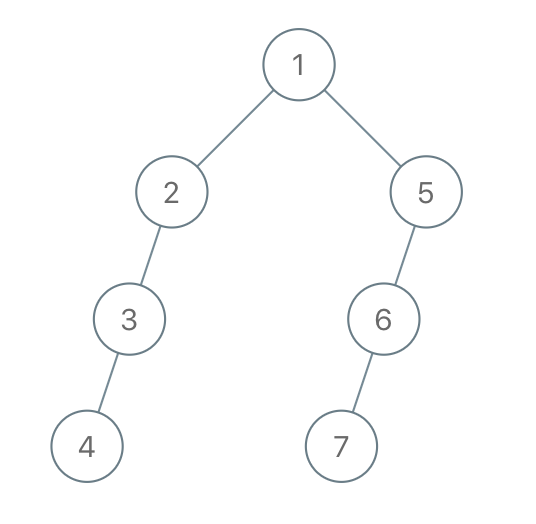1028.Recover a Tree From Preorder Traversal¶
Tags: Hard Tree Depth-first Search
Links: https://leetcode.com/problems/recover-a-tree-from-preorder-traversal/
We run a preorder depth first search on the root of a binary tree.
At each node in this traversal, we output D dashes (where D is the depth of this node), then we output the value of this node. (If the depth of a node is D, the depth of its immediate child is D+1. The depth of the root node is 0.)
If a node has only one child, that child is guaranteed to be the left child.
Given the output S of this traversal, recover the tree and return its root.
Example 1:

Input: "1-2--3--4-5--6--7"
Output: [1,2,5,3,4,6,7]
Example 2:

Input: "1-2--3---4-5--6---7"
Output: [1,2,5,3,null,6,null,4,null,7]
Example 3:

Input: "1-401--349---90--88"
Output: [1,401,null,349,88,90]
Note:
- The number of nodes in the original tree is between
1and1000. - Each node will have a value between
1and10^9.
构建二叉树一般采用递归的方法去构建,和LeetCode 297.二叉树的序列化与反序列化思路上有共同点,可以认为本题是二叉树序列化的一种方式,现在题目给出了序列化的结果,我们需要进行反序列化的操作。
用一个全局变量pos记录读取到字符串s中的位置,构建根节点时,用end指向pos后面的第一个-字符,或者指向字符串末尾,构建完根节点,pos移动到根节点数字的最后一个数字,比如说根节点数字为401,最开始pos指向4,构建完根节点后pos指向1。
然后构建左右子树,用cnt去记录-字符的数量,参数depth代表上一层的深度,如果cnt = depth + 1,那么意味着一定存在左子节点(题目保证如果节点只有一个子节点,一定是左子节点),所以此时需要移动pos的位置,让其继续指向数字。如果cnt != depth + 1,那么意味着根节点的左子节点不存在。
然后构建右子节点,这时候pos的位置可能更新了,也可能并没有变化,所以仍然需要继续用end指向pos后面的第一个-字符,或者指向字符串末尾,继续用cnt去记录-的数量,完成右子树的构建。
只需要遍历依次字符串s即可完成构建,时间复杂度O(n)。
最开始写了一个版本,写完后发现构建左右子树的代码其实是一样的,可以进一步进行优化:
/**
* Definition for a binary tree node.
* struct TreeNode {
* int val;
* TreeNode *left;
* TreeNode *right;
* TreeNode(int x) : val(x), left(NULL), right(NULL) {}
* };
*/
class Solution {
int pos;
public:
TreeNode* recoverFromPreorder(string s) {
std::ios_base::sync_with_stdio(false);
cin.tie(NULL);
cout.tie(NULL);
if (s.size() == 0) return NULL;
pos = 0;
TreeNode *root = build(s, 0);
return root;
}
TreeNode *build(const string & s, int depth)
{
int end = (s.find("-", pos) == string::npos) ? (int)s.size() : s.find("-", pos);
TreeNode *root = new TreeNode(stoi(s.substr(pos, end - pos)));
pos += end - pos - 1;
int cnt = 0;
for (int i = end; i < s.size(); ++i) {
if (s[i] == '-') ++cnt;
else break;
}
pos += (cnt == depth + 1) ? cnt + 1 : 0;
root -> left = (cnt == depth + 1) ? build(s, depth + 1) : NULL;
end = (s.find("-", pos) == string::npos) ? (int)s.size() : s.find("-", pos);
cnt = 0;
for (int i = end; i < s.size(); ++i) {
if (s[i] == '-') ++cnt;
else break;
}
pos += (cnt == depth + 1) ? cnt + 1 : 0;
root -> right = (cnt == depth + 1) ? build(s, depth + 1) : NULL;
return root;
}
};
优化的递归版本,此时让pos每次指向数字后的第一个-,用cnt去记录-的个数,优先计算-,代表马上要建立的节点的深度,depth代表当前层的深度,如果cnt != depth,意味着接下来的数字并不属于这一层,所以直接返回即可。
如果相等,那么让pos移动cnt个位置,指向-后的第一个数字,然后用end指向数字后的-,提取出数字,构建根节点,此时pos移动到end的位置,于是pos又指向了数字后的第一个-,于是就可以递归的去构建左右子树了。
/**
* Definition for a binary tree node.
* struct TreeNode {
* int val;
* TreeNode *left;
* TreeNode *right;
* TreeNode(int x) : val(x), left(NULL), right(NULL) {}
* };
*/
class Solution {
int pos;
public:
TreeNode* recoverFromPreorder(string s) {
std::ios_base::sync_with_stdio(false);
cin.tie(NULL);
cout.tie(NULL);
if (s.size() == 0) return NULL;
pos = 0;
TreeNode *root;
build(s, root, 0);
return root;
}
void build(const string & s, TreeNode *&root, int depth)
{
int cnt = 0;
for (int i = pos; i < s.size(); ++i) {
if (s[i] == '-') ++cnt;
else break;
}
if (cnt != depth) { root = NULL; return; }
pos += cnt;
int end = (s.find("-", pos) == string::npos) ? (int)s.size() : s.find("-", pos);
root = new TreeNode(stoi(s.substr(pos, end - pos)));
pos += end - pos;
build(s, root -> left, depth + 1);
build(s, root -> right, depth + 1);
}
};